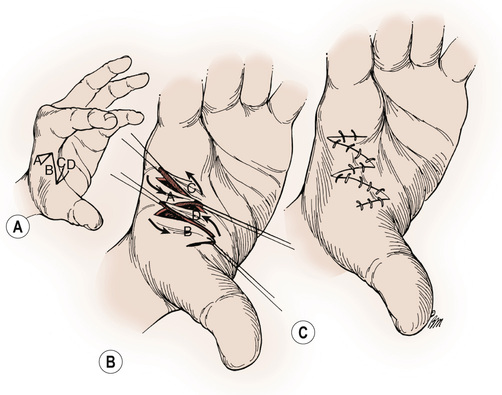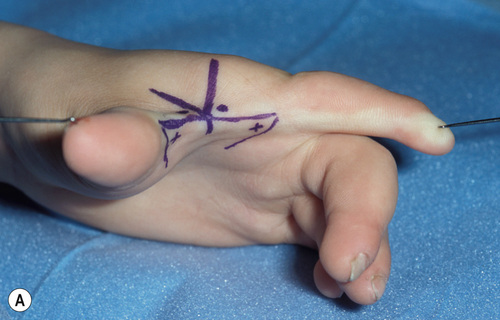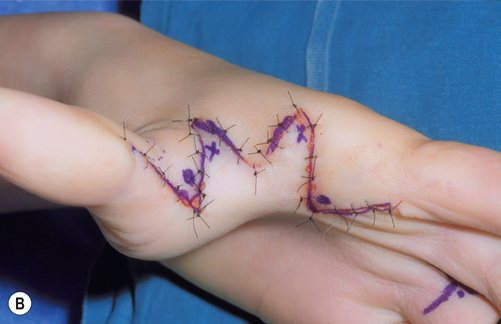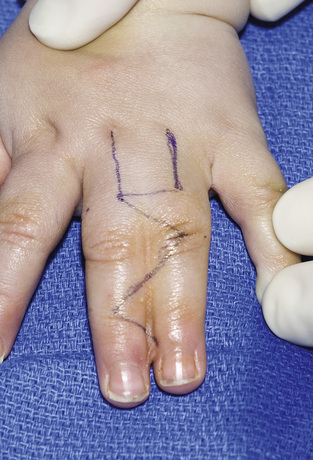1. Hand development occurs during the 4th to 8th gestational weeks (see Table 14.1). ● 3 to 4 weeks’ gestation: Upper limb bud formation ● 4 to 5 weeks’ gestation: Proximal-to-distal upper limb development ● By week 5, the upper limb is formed without digital separation. ● By week 8, complete development of the upper limb and hand occurs. Table 14.1 Timing of Hand Formation 2. Signaling pathways involved in upper limb development (see Table 14.2) 1. Type I: Failure of formation of parts ● Includes cases of longitudinal or transverse arrest 2. Type II: Failure of differentiation (separation) of parts ● Includes all cases of inadequate separation of parts 3. Type III: Duplication disorders ● Includes all cases of duplication ■ Whole limb duplication and/or mirror hand ● Includes macrodactyly or hemihypertophy 6. Type VI: Constriction band syndrome 7. Type VII: Generalized skeletal deformities ● Includes all generalized syndromes 1. Deficiencies can range from mild thumb hypoplasia to complete absence of the radius. 2. All forms of radial deficiency warrant systemic evaluation for syndromes or associations (see Table 14.3). Table 14.3 Syndromes Associated with Radial Deficiency ● Occurs most commonly as part of radial deficiency ● Blauth classification (see Table 14.4) ■ Correlates with degree of deficiency and necessary treatment Table 14.4 Thumb Deficiency Classification and Treatment Paradigm ■ The main determinant for thumb reconstruction and/or pollicization is the presence (Type IIIA) or absence (Type IIIB) of a stable carpometacarpal (CMC) joint. ∘ Type-IIIA thumb: The child incorporates thumb into routine use. ♦ Great toe to thumb transfer is an excellent option when most of the metacarpal is present. ∘ Type-IIIB thumb: Thumb is ignored by child and grasp actions occur between fingers. ♦ Pollicization is the procedure of choice. ➔ Movement of the metacarpal and neurovascular (NV) pedicle for a finger ➔ Also indicated for Type-IV and -V thumbs ● Options to release/deepen the web space ■ 4-flap Z (4Z) plasty (see Figure 14.1) ■ 5 Z (5Z) plasty or “jumping man” flap (see Figure 14.2) 1. Failure of differentiation disorder (Type II) 2. Abnormal interconnection between adjacent digits ● Familial form inherited in an autosomal dominant pattern 3. Classified according to the degree and extent of the interconnection ● Simple syndactyly involves only skin and fibrous tissue. ● Complex syndactyly involves skin, fibrous tissue, and bone. ● Complete syndactyly: The entire length of finger is involved, including the fingertip/nail. ● Incomplete syndactyly: The fingertip/nail is spared. 4. Treatment ● Separation of border digits by 4 to 6 months of age to limit tethering and growth disturbances ● Can delay separation of other digits up to 18 months ● If multiple fingers are involved, release only one side of the digit to prevent vascular compromise. ● Release often involves a combination of full-thickness skin grafts and local flaps. ■ Occasionally, incomplete syndactyly can be closed with local flaps alone. ● Dorsal skin flaps should be used for web-space resurfacing (see Figure 14.3). 1. Signs: Painless flexion contracture of the small-finger proximal interphalangeal (IP) joint 2. Epidemiology ● Occurs during infancy and adolescence ● The majority of cases are bilateral. ● Most often involves the small finger, but other fingers can be affected. ■ Prevalence of finger involvement decreases as you progress to the radial side of the hand. 4. Treatment ● Observation, passive stretching, and splinting ● Surgery for progressive deformities that are fixed or lead to functional impairment
Congenital Hand Disorders
General Embryology
Time After Fertilization
Hand Development
27 days
Development of arm bud
28-30 days
Further development of arm bud
34-36 days
Elongation of arm bud
34-38 days
Formation of hand paddle
38-40 days
Early separation of digits
44-46 days
Digits separated
Week 9-10
Formation of fingernails begins
Classification of Congenital Hand Disorders
Radial Deficiencies
Syndrome
Characteristics
Holt-Oram
Heart defects; most commonly, cardiac septal defects
TAR
Thrombocytopenia–absent radius syndrome; present at birth but improves over time
VACTERL
Vertebral abnormalities, anal atresia, cardiac abnormalities, tracheoesophageal fistula, esophageal atresia, renal defects, radial dysplasia, lower limb abnormalities
Fanconi’s anemia
Aplastic anemia not present at birth; develops at about 6 years of age. Fatal without bone marrow transplant; chromosomal challenge test now available for early diagnosis
Type
Findings
Treatment
I
Minor generalized hypoplasia
Augmentation or no treatment
II
Absence of intrinsic thenar muscles, first web-space narrowing, UCL insufficiency
Opponensplasty, first web release, UCL reconstruction
III
Similar findings as Type II, extrinsic muscle and tendon abnormalities, skeletal deficiency
A: Stable CMC joint
B: Unstable CMC joint
A: Reconstruction
B: Pollicization
IV
“Pouce flottant,” or floating thumb
Pollicization
V
Absence
Pollicization
Syndactyly
Camptodactyly
![]()
Stay updated, free articles. Join our Telegram channel

Full access? Get Clinical Tree


Congenital Hand Disorders
Chapter 14











